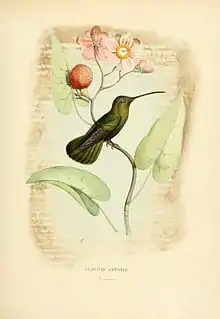Sooty barbthroat
The sooty barbthroat (Threnetes niger) is a hummingbird species in the family Trochilidae.
| Sooty barbthroat | |
|---|---|
 | |
| Scientific classification | |
| Kingdom: | Animalia |
| Phylum: | Chordata |
| Class: | Aves |
| Order: | Apodiformes |
| Family: | Trochilidae |
| Genus: | Threnetes |
| Species: | T. niger |
| Binomial name | |
| Threnetes niger | |
| Synonyms | |
|
Trochilus niger Linnaeus, 1758 | |
It is found in French Guiana and the northeastern part of the Amazon Basin. Its natural habitat is humid tropical lowland forest.
Taxonomy
The sooty barbthroat was formally described by the Swedish naturalist Carl Linnaeus in 1758 in the tenth edition of his Systema Naturae under the binomial name Trochilus niger. [2] The type locality is Cayenne in French Guiana.[3] The sooty barbthroat is now placed in the genus Threnetes that was introduced by John Gould in 1852.[4][5]
Two subspecies are recognised:[5]
- T. n. niger (Linnaeus, 1758) – French Guiana and northeast Brazil
- T. n. loehkeni Grantsau, 1969 – northeast Brazil (north of the Amazon)
The taxonomy and systematics of the sooty/pale-tailed barbthroat complex has caused much confusion. Some authors[6] consider the sooty barbthroat to be a melanistic variant of the pale-tailed barbthroat (T. leucurus). As T. niger was described first, this scientific name is the valid name for both when they are considered conspecific.
On the other hand, the SACC for example considers T. niger and T. leucurus distinct species, because of insufficient published evidence for their being conspecific.[7] This "combined" species is considered to be of Least Concern by the IUCN.[1][8]
In addition, some suggest that the bronze-tailed barbthroat (T. n. loehkeni) should also be considered a valid species and include the doubtful Christina's barbthroat (T. n. christinae) as a subspecies. Freire's sooty barbthroat (T. n. freirei) is intermediate between the sooty and bronze-tailed barbthroats however, and thus its status needs to be clarified before the situation is resolved.[9]
References
- BirdLife International (2012). "Threnetes niger". IUCN Red List of Threatened Species. 2012. Retrieved 26 November 2013.CS1 maint: ref=harv (link)
- Linnaeus, Carl (1758). Systema Naturae per regna tria naturae, secundum classes, ordines, genera, species, cum characteribus, differentiis, synonymis, locis (in Latin). Volume 1 (10th ed.). Holmiae (Stockholm): Laurentii Salvii. p. 121.
- Peters, James Lee, ed. (1945). Check-List of Birds of the World. Volume 5. Cambridge, Massachusetts: Harvard University Press. p. 6.
- Gould, John (1852). A Monograph of the Trochilidae, or Family of Humming-Birds. Volume 1. London: self. Plates 13, 15 and text (Part 4 Plates 14, 15). The 5 volumes were issued in 25 parts between 1849 and 1861. Title pages of all volumes bear the date of 1861.
- Gill, Frank; Donsker, David; Rasmussen, Pamela, eds. (January 2021). "Hummingbirds". IOC World Bird List Version 11.1. International Ornithologists' Union. Retrieved 6 February 2021.
- E.g. Hinkelmann (1999)
- SACC (2003)
- BLI (2008)
- Mallet-Rodrigues (2006)
Sources
- Hinkelmann, Christoph (1999): 8. Pale-tailed Barbthroat. In: del Hoyo, Josep; Elliott, Andrew & Sargatal, Jordi (eds.): Handbook of Birds of the World (Vol. 5: Barn-owls to Hummingbirds): 539, plate 45. Lynx Edicions, Barcelona. ISBN 84-87334-25-3
- Mallet-Rodrigues, Francisco (2006): Táxons de aves de validade questionável com ocorrência no Brasil. III – Trochilidae (I) [Questionable bird taxa with occurrence in Brazil. III – Trochilidae (I)]. Revista Brasileira de Ornitologia 14(4): 475-479 [Portuguese with English abstract]. PDF fulltext
- South American Classification Committee (SACC) (2003): Proposal (# 77) to South American Check-list Committee: Split Threnetes leucurus from Threnetes niger. Retrieved 2008-OCT-31.
External links
- Sooty Barbthroat rangemap
- Stamps: Threnetes niger (misnamed at site), RangeMap
- Sooty Barbthroat photo gallery VIREO
